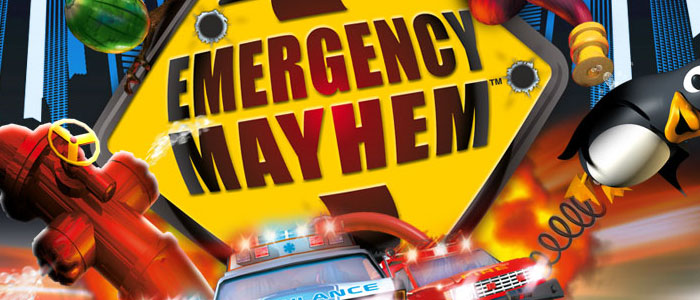When it was released Crazy Taxi was one of the most original and fun experiences to come out of Sega’s ill-fated console. The twitch driving mechanic and simplistic premise made it a quick fan-favorite among all who dropped the disc into their console. Funny thing was not many companies attempted to capitalize on the idea with their own version. Originally announced for Xbox and PS2 back in 2004 Codemaster’s latest title Emergency Mayhem was Acclaim’s answer to the Crazy Taxi phenomenon, unfortunately outside of a few waggle-induced gimmicks the game looks and feels as old as it’s original conception.
Emergency Mayhem is a fast-paced arcade driving game that is broken down into three categories. You take control of either the police department, fire department or ambulance services as you race around town performing mini-tasks that involve both driving as well as a host of waggle-induced mini-games. Everything in Crisis City is time based, so if you are not a fan of racing against the clock this will be strike one. Mayhem is the epitome of ADD gaming; everything moves so fast and frantic that you will rarely have time to digest everything you are given to do.
While there are in fact three separate campaigns to trudge through they all feel disappointingly similar. Each section involves driving around a colorful city from one task to the next before time runs out. As a police officer you will deliver criminals, disarm bombs and repair street lights. Firefighters will use waggle to shut off fire hydrants while ambulance drivers get to perform what is essentially a watered down form of Trauma Center. All of the games feel amazingly simple and even with their archaic nature feel intuitive, albeit repetitive. The driving is probably the highlight of the package outside of the developer’s obscure decision to place the gas on the B button and the brake and reverse on A.
Crisis City is a colorful one, and there is certainly a hidden charm in seeing criminals with giant purple arrows glowing above their head. Developer Supersonic has created a world reminiscent of old-school arcade drivers that should appease fans. However there is more than a fair share of issues with said world. For starters the arrow that guides you from place to place is borderline useless. Often times it will lead you into a wall while other times down a one way dead end alley. Couple this with the fact that the city is simply not designed for free-roam driving and you create several problems with navigation. This is further enforced when you realize that some of the missions force you to avoid hitting obstacles and walls while performing them. The claustrophobic vibe of the city and the sheer amount of pedestrians and traffic scattered about make these missions as frustrating as they are monotonous.
Mini-games don’t fare much better. The palette of options is small and you will be performing the same ones over and over during your session with each branch of rescue services. Within the first ten minutes of game time I had defused at least five bombs and each one marginally harder than the last. These games are also made the less exciting by their by-the-numbers use of motion control. I am sorry if I don’t find moving objects on the screen as inventive as actually controlling the devices that other games on the system have proven does work. Aside from the repetition and lack of innovation the games are perfect for gamers with a lack of patience. Think of them almost as Wario Ware games and you will better appreciate them for their simplicity and accessibility.
Visually Emergency Mayhem is certainly not a looker. The game was announced in 2004 and looks like it was developed in conjunction with the development of the late great Dreamcast. Simplistic polygonal models and characters sporting less than a dozen animations are commonplace, while the city itself is comprised of invisible walls and traffic cones that are apparently welded to the pavement. The color palette is easy on the eyes and does paint a gorgeous backdrop and as far as frame rate goes you can hardly ask for more. It is also worth mentioning that the game supports widescreen 480p resolution running at a 16×9 ratio and rarely ever drops below 60 frames per second.
If Emergency Mayhem had been released around the same time as Sega’s ill-fated taxi simulator it may have turned a few more heads. While the system of choice was probably the best (360 and PS3 owners would have simply laughed hysterically at this game on their console of choice) the price deters most onlookers. If released at $19.99 the game may have had a chance with the twitch racing crowd; but at $40 the barrier to entry is simply too high for most of the casual audience that the game would likely appease. However if you are a fan of classic arcade driving games like Sega’s aforementioned cabbie title then you may want to check Mayhem out. It can definitely entertain even if only for minutes at a time.
